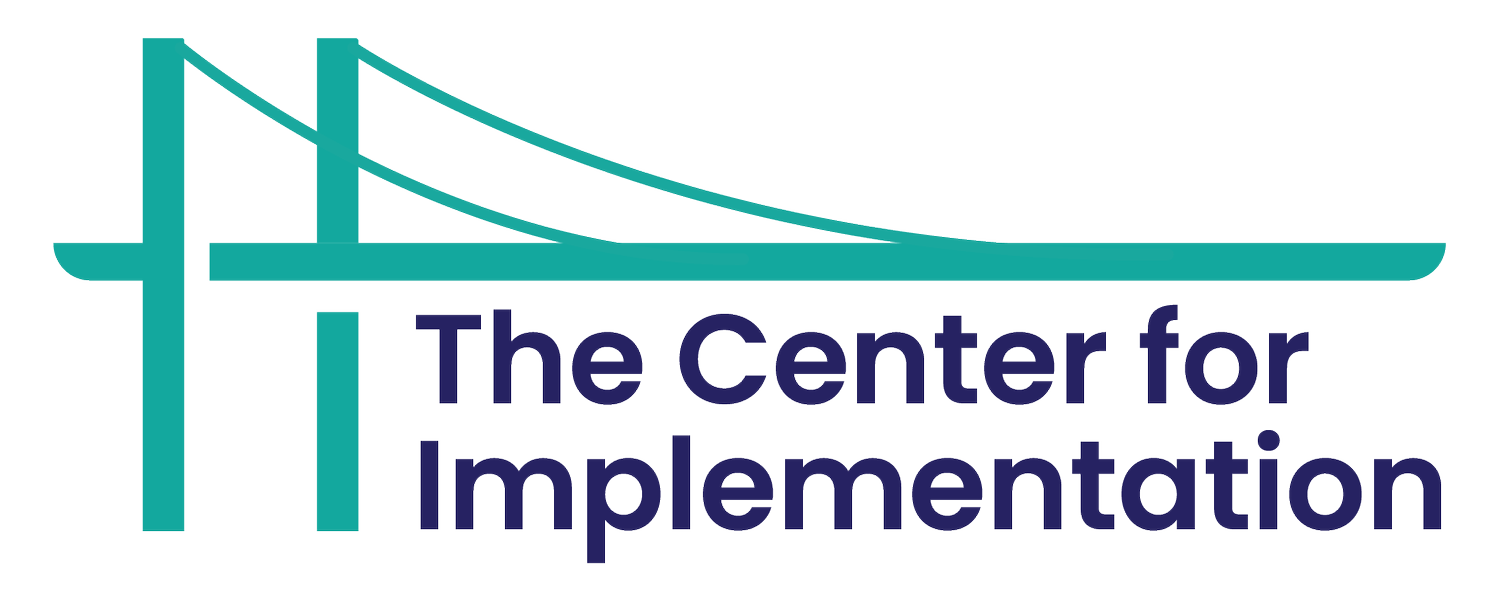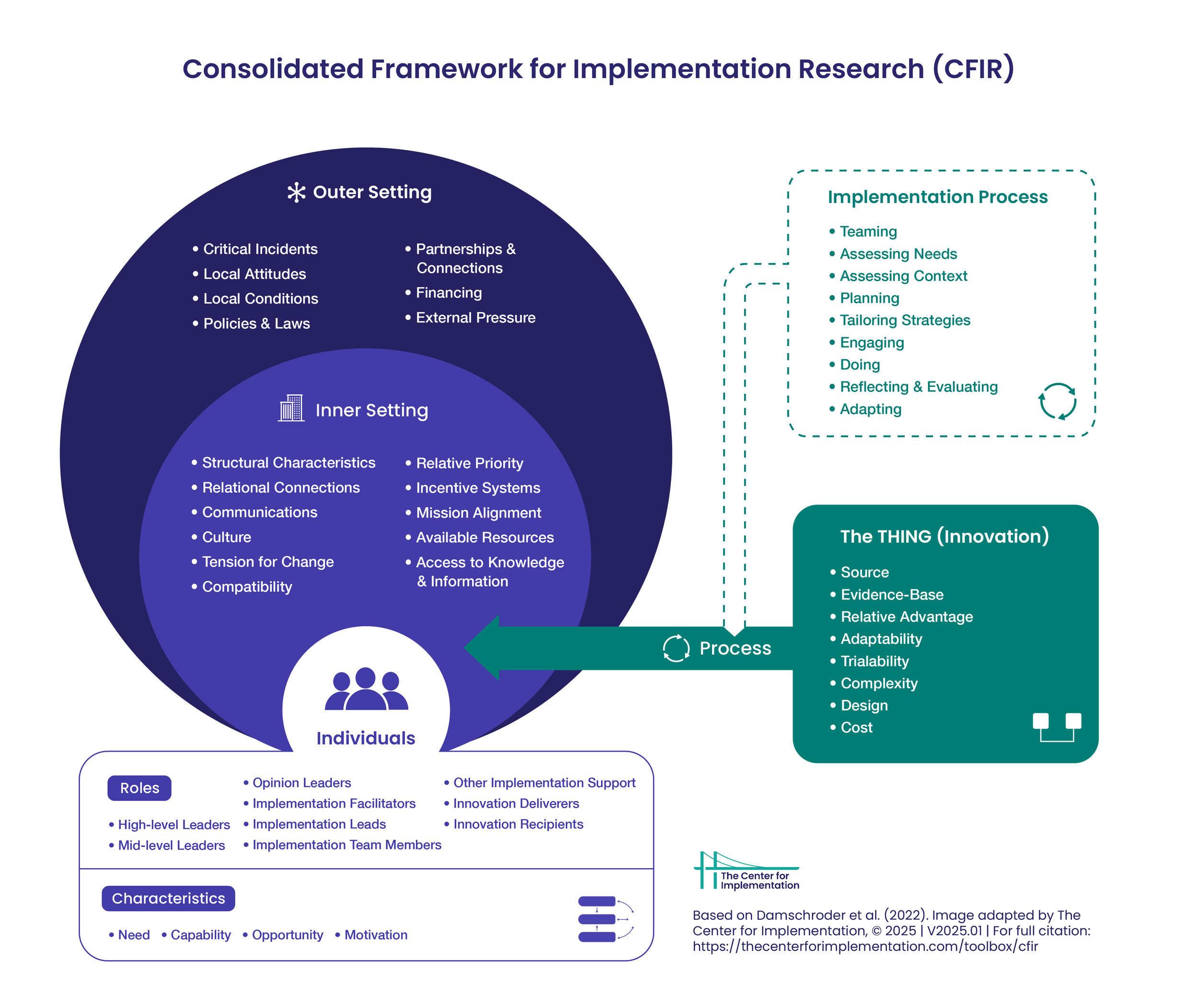Using the Consolidated Framework for Implementation Research (CFIR) in Implementation Research and Practice
By Dr. Sobia Khan, Director of Implementation
5-min read
The Consolidated Framework for Implementation Research (CFIR) is arguably the most widely used implementation research framework by both researchers and practitioners worldwide. Several years ago, while attempting to integrate the CFIR into our courses, we reimagined its diagram to illustrate the relationships between different domains. This updated figure remains our most downloaded image to date.
Despite its popularity, many individuals are still unsure how to effectively utilize the CFIR. This includes researchers who are new to implementation science and find it challenging to apply the CFIR in their studies, as well as practitioners who are uncertain about how to use the CFIR for planning implementation strategies.
Here, we provide an overview of the CFIR and offer tips for both researchers and practitioners on effectively applying this implementation framework.
The CFIR was originally published in 2009, with an updated version, known as The updated Consolidated Framework for Implementation Research, released in 2022. Additionally, there is a dedicated website that hosts various CFIR-related resources.
What is the Consolidated Framework for Implementation Research (CFIR)?
The CFIR is a framework that describes factors affecting implementation. These factors are often called “determinants” as they determine the success or failure of implementation efforts. Consequently, the CFIR is often referred to as a “determinant framework”.
As a determinant framework, the CFIR is particularly useful for addressing questions about the key barriers and facilitators to effective implementation. There are 5 domains of the CFIR that describe different kinds of factors or determinants you may encounter:
Inner Setting
The inner setting refers to the environment within the organization or system where implementation is taking place. This includes the people, culture, resources, structures, and internal processes that influence how change happens. For example, the level of leadership support, openness to change, communication among teams, or whether staff feel they have time and capacity to take on new initiatives—all fall within the inner setting. These factors can vary widely across sites and play a critical role in shaping how implementation unfolds. You may also encounter a situation where you have many inner settings, so you will consider the contexts of each one of those settings.
Outer Setting
The outer setting focuses on the broader context outside the organization that may influence implementation efforts. This includes community needs, funding requirements, regulatory environments, relationships with partners, and other external pressures. For instance, changes in government policy, expectations from funders, or the availability of community supports can strongly affect what gets implemented and how. Understanding these external factors is important, especially when working across systems or adapting to shifting priorities.
Individual characteristics
As the THING is being implemented, certain people may be involved in making implementation happen, as well as others who are affected by the change caused by the THING. Understanding who impacts and is impacted by implementation, and what their barriers and facilitators are, is imperative. While the updated version of the CFIR, expands the individual characteristics section, people often use a different framework to unpack the individual characteristics. We often see people use the Theoretical Domains Framework (TDF).
People often ask: How do the CFIR and TDF fit together? This is where that happens. The TDF is a more detailed version of individual characteristics, and the CFIR has much more nuance regarding the inner and outer settings.
Innovation characteristics
As people consider a THING (innovation) they want to implement, there may be aspects of the THING that make people more likely to want to adopt it. For example, if something is highly evidence-based, is a reasonable cost, and was developed by a reputable organization, potential adopters may more highly value it. Note that different types of adopters might value different characteristics of the THING (for example, evidence is not important for all people), so assessing what makes the THING acceptable, feasible, and appropriate based on these factors from the perception of the intended users is a key part of both research and practice.
Process
This domain broadly describes different steps that may be used to implement the THING once a decision to adopt has been made. It is not intended to comprehensively guide implementation, as there are robust process models that can do this (for example, Getting to Outcomes, Quality Implementation Framework…, etc.). The best use of this domain is to reflect on how implementation occurs and recognize any aspects of the process that may have affected implementation (for example, not taking enough time to prepare for implementation).
How can I use the CFIR
The CFIR was developed retrospectively to evaluate what happened during implementation. Suppose you are in a situation where implementation has already started, and you want to know what went well and what didn’t. In that case, using the domains, you can apply the CFIR to unpack the factors of determinants that contributed to implementation. The developers of the CFIR have created excellent guidance and tools (for example, interview guides and codebooks) for this purpose on the website. Note that different determinants in the CFIR can be combined to indicate different implementation outcomes, as noted in Proctor’s taxonomy of outcomes. For example, complexity and cost can determine whether or not implementing the THING is feasible. When assessing implementation outcomes, you can use the CFIR to specify indicators for those outcomes.
Many years ago, TCI started using the CFIR prospectively to plan for implementation, which was a more novel application of the framework at the time. We thought it was a great framework to help us determine barriers and facilitators (particularly in the inner and outer settings), and to link those to strategies during the planning phase. The developers of CFIR have also created guides and tools for this purpose. One example is the CFIR-ERIC matching tool, which can be used to help select implementation strategies from the ERIC list based on barriers and facilitators.
CFIR for low- and middle-income countries and other adapted versions
As CFIR has become incredibly popular as an implementation framework, it has also been considered for different uses and contexts and therefore has been adapted. A major known adaptation to the CFIR is CFIR for low- and middle-income countries, which considers the original CFIR and adapts some of the determinants to reflect contexts in these countries.
Our own Context Compass Framework was based on CFIR inner and outer setting determinants, which we adapted to reflect global contexts better and emphasize determinants that have been gaining importance in practice, such as relationships.
The CFIR provides a practical way to unpack the contextual conditions that shape implementation, both inside and outside of organizations. By reflecting on the inner and outer settings—alongside the characteristics of the innovation, the individuals involved, and the implementation process—researchers and practitioners can better anticipate challenges and design more tailored strategies. Whether used to guide planning or evaluation, the CFIR helps make the invisible influences on implementation more visible and actionable.
This article was featured in our monthly Implementation in Action bulletin! Want to receive our next issue? Subscribe here.

